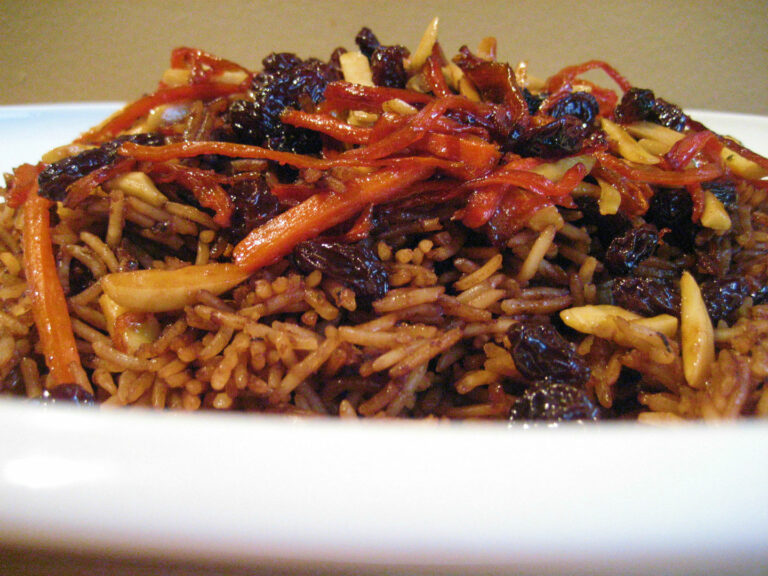Introduction: What is Afghan Street Food?
Afghan street food is a unique blend of flavors and cultural influences that have evolved over centuries. Street food in Afghanistan is a common sight, especially in urban areas, where people often grab a quick bite to eat while on the go or for a casual meal with friends and family. The street food scene in Afghanistan is diverse, ranging from savory flatbreads to grilled meats, soups, and stews.
Afghan street food is known for its use of aromatic spices, bold flavors, and fresh ingredients. The cuisine is heavily influenced by the country’s location on the Silk Road, which saw a mix of influences from Indian, Persian, and Central Asian cuisines. Afghan street food is also reflective of the country’s history, with flavors and techniques that have been passed down through generations of families and communities.
The Cultural Significance of Afghan Cuisine
Afghan cuisine is an essential part of the country’s cultural heritage. It is a way for Afghans to connect with their past, their families, and their communities. The cuisine is often associated with hospitality, and it is common for Afghans to welcome guests with a feast of traditional dishes.
Afghan cuisine is also steeped in religious and cultural traditions. Many dishes are prepared during religious and cultural holidays, such as Ramadan and Eid, and are eaten as a way to honor these occasions. Moreover, Afghan cuisine is known for its communal aspect, with family and friends gathering around a shared meal to socialize, celebrate, and reconnect.
The History of Afghan Street Food
Street food in Afghanistan has a long history dating back to the Silk Road era. As traders and travelers passed through the region, they brought with them new ingredients, flavors, and cooking techniques that influenced the development of Afghan cuisine.
Over time, street food became an integral part of Afghan culture, with vendors selling their wares on street corners, bazaars, and markets. Today, street food vendors are a common sight in urban areas, providing affordable and convenient meals to people on the go.
Ingredients and Cooking Techniques in Afghan Street Food
Afghan street food is known for its use of bold spices, fresh ingredients, and cooking techniques that have been passed down through generations. Key ingredients in Afghan street food include lamb, chicken, chickpeas, lentils, rice, and a variety of vegetables.
Cooking techniques in Afghan street food include grilling, stewing, and baking. The use of a tandoor, a clay oven used for baking bread and meats, is common in Afghan cuisine. Spices such as cumin, coriander, cardamom, and turmeric are also widely used to add flavor and aroma to dishes.
Popular Afghan Street Food: Kabuli Pulao and Bolani
Kabuli Pulao is one of the most popular dishes in Afghan street food. It is a rice dish made with lamb or chicken, raisins, carrots, and other spices. Bolani, another popular street food, is a savory flatbread stuffed with potatoes, spinach, or pumpkin.
Other popular street food dishes in Afghanistan include Mantu, a dumpling filled with ground beef or lamb, and Ashak, a pasta dish filled with leeks or scallions and topped with meat or vegetables.
Regional Variations in Afghan Street Food
Afghanistan is a diverse country, and there are many regional variations in Afghan street food. In the north, dishes such as Mantu and Ashak are popular, while in the south, barbecue and grilled meats are common.
The western region of Afghanistan is known for its bread, with different types such as naan, lavash, and chapati, while the eastern region is known for its soups and stews. Vegetarian dishes are also popular in some regions, particularly in the central highlands.
Street Food in Afghan Society: Socializing and Celebration
Street food plays an essential role in Afghan society, providing a casual and communal atmosphere for people to gather, socialize, and celebrate. Street food vendors are often a common sight at weddings, festivals, and other cultural events, providing affordable and accessible meals to attendees.
Moreover, street food is often associated with a sense of nostalgia and memories, with people often seeking out their favorite vendors for their favorite dishes. Street food is also a way for Afghans to connect with their past and traditions, with vendors often using age-old techniques and recipes passed down through generations.
The Future of Afghan Street Food: Challenges and Opportunities
The street food scene in Afghanistan faces several challenges, ranging from economic to health and hygiene issues. However, there are also opportunities for the street food industry to grow and evolve, particularly with the rise of tourism and interest in Afghan cuisine globally.
There is a growing interest in authentic and traditional dishes, and vendors and chefs have the opportunity to showcase the diversity and richness of Afghan cuisine. Moreover, initiatives to improve the quality and safety of street food, such as training programs and regulations, can provide a more sustainable and lucrative future for the industry.

